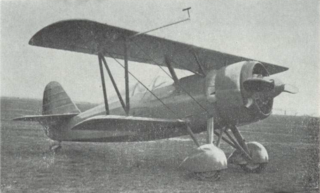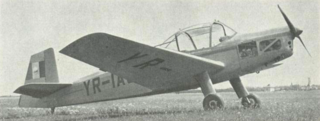
The SET 10 was a trainer aircraft produced in Romania in prototype form in the early 1930s. It was a conventional, single-bay biplane with staggered wings braced with N-struts. It was equipped with fixed tailskid undercarriage, and seated the pilot and instructor in tandem, open cockpits. Intended for Romania's aeroclubs and Air Force, no production ensued.

The SET XV was a fighter aircraft developed in Romania in the mid-1930s. It was a conventional single-bay biplane with staggered wings of unequal span braced by N-struts. It was fitted with fixed tailwheel undercarriage with spatted mainwheels. The cockpit was fully enclosed, and the engine was fitted with a NACA cowl. Construction throughout was fabric-covered metal.
The IAR-822 was an agricultural aircraft built in Romania in the 1960s. Based on the IAR-821, it was a conventional low-wing monoplane with fixed, tailwheel undercarriage and differed from its predecessor mainly in the choice of a horizontally opposed engine in place of a radial.

The IAR 27 was a 1930s Romanian two-seat low-wing monoplane primary trainer designed and built by Industria Aeronautică Română.
The IS-3 was the basis of a family of high performance gliders designed by Iosif Şilimon and built in Romania in the 1950s at the URMV-3 factory at Braşov.
The IS-2 was an intermediate training glider designed by Iosif Şilimon and built in Romania in the 1950s at the URMV-3 factory at Brașov.
The IS-4 was a high performance glider designed by Iosif Şilimon and built in Romania in the late 1950s at the URMV-3 factory at Braşov.
The Aichi Experimental Type 15-Ko Reconnaissance Seaplane (Mi-go) was a prototype reconnaissance seaplane built by Aichi in the mid-1920s.
The CANT Z.504 was a prototype reconnaissance biplane flying boat made by CANT in the 1930s.
The Caspar C 24 was a German two-seat biplane sports aircraft that flew in 1925.
The Caspar C 33 was a training aircraft developed in Germany in the late 1920s.
The IAR-818 was a Romanian multipurpose aircraft based on the IAR-817. It was developed by IAR in both landplane and floatplane forms.
The IAR-817 was a Romanian multipurpose aircraft built in the 1950s.

The IAR-813 was a Romanian trainer aircraft based on the IAR-811. It differed from the IAR 811 in having a bubble canopy and more powerful engine.

The IAR-811 was a Romanian trainer aircraft built in the late 1940s. It was the first aircraft designed and built in Romania following the end of the Second World War.
The Romano R.15 was an amphibious aircraft built in France by Romano in the early 1930s.

The IAR-814, aka MR-2, was a Romanian designed and built twin-engined trainer aircraft built in the early 1950s, the first twin-eninged aircraft wholly designed and built in Romania.
The IMAM Ro.26, sometimes called the Romeo Ro.26, was a single-engine biplane trainer aircraft produced by the Italian aeronautical company IMAM in the early 1930s. Only one example was built.

Proto 1 was a training biplane designed by Major Ștefan Protopopescu in collaboration with Dumitru Baziliu and Gheorghe Ticău at Arsenalul Aeronautic in Bucharest in 1922. It was the first Romanian airplane to be built in a specialized enterprise.

Proto 2 was a training biplane manufactured at the Fabrica de avioane Astra in Arad in 1924.









